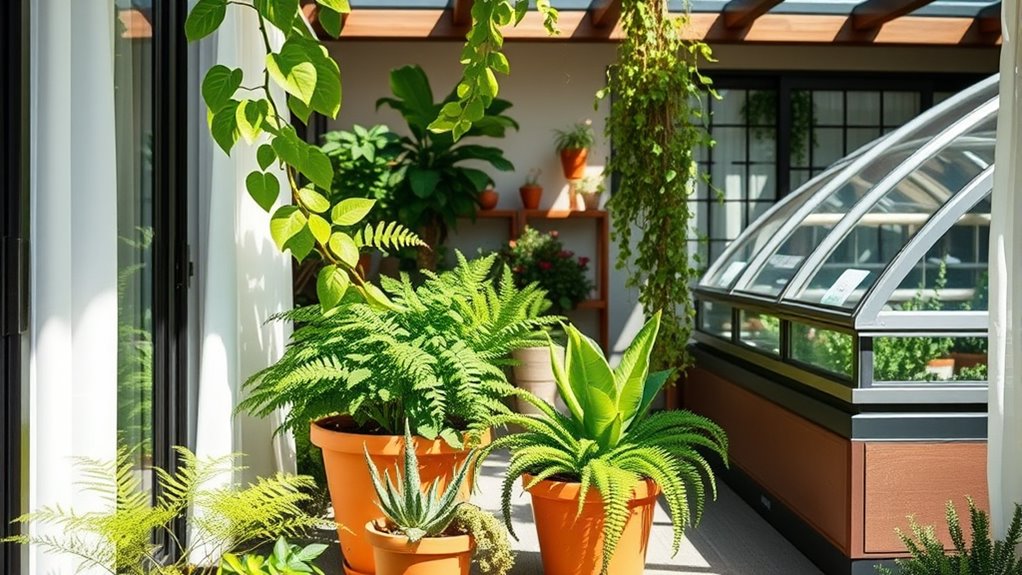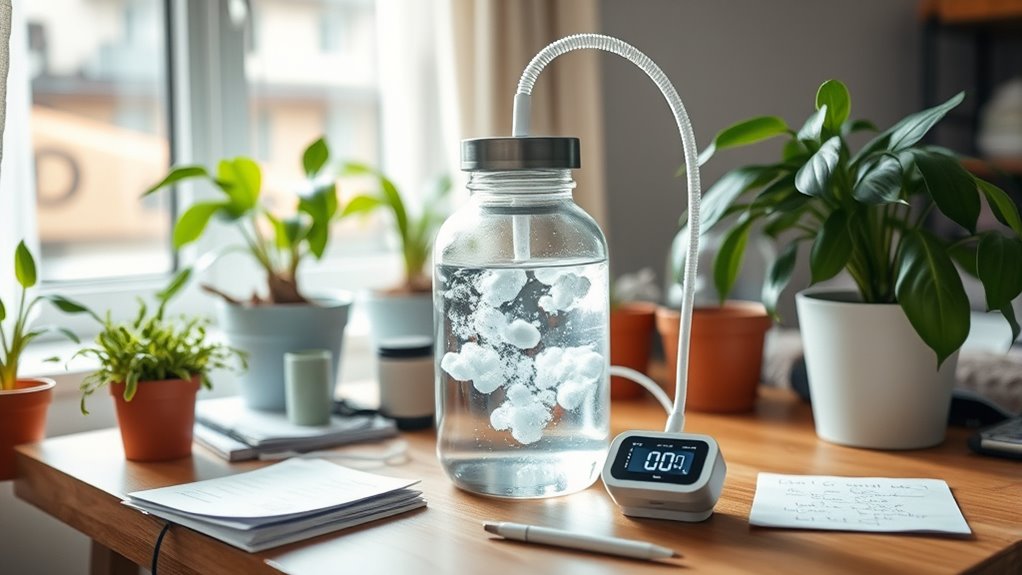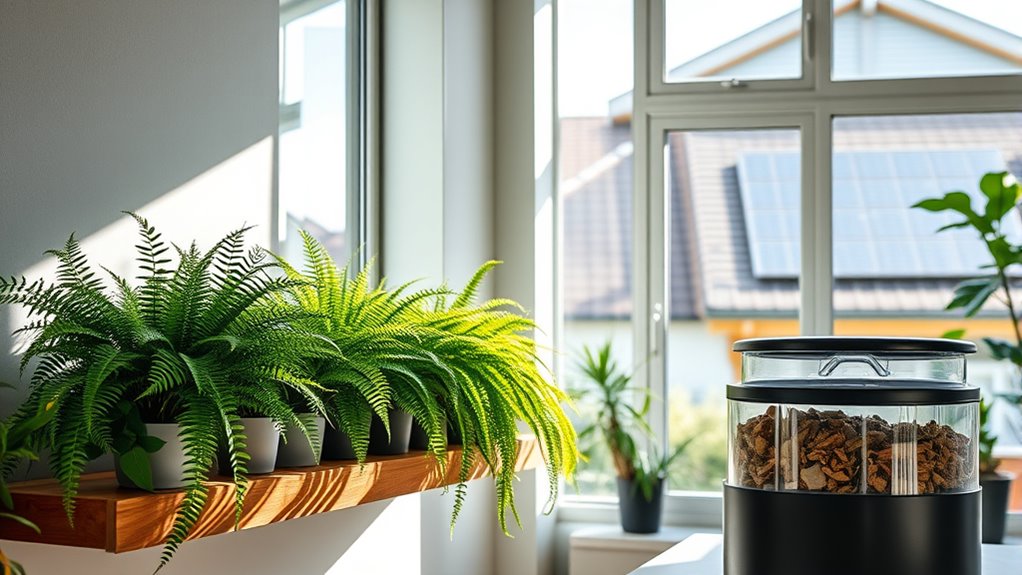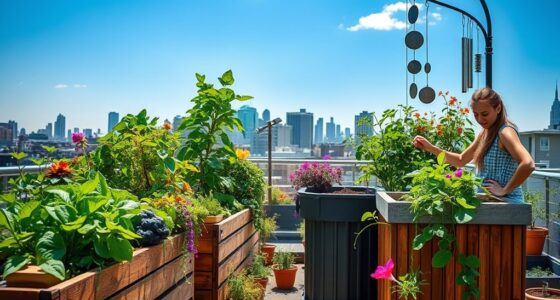To lower your footprint at home, start by adding indoor plants like pothos and snake plants, which naturally filter air and increase humidity. Improve energy efficiency by sealing leaks, upgrading insulation, and installing solar panels. Consider DIY projects like activated charcoal filters to absorb CO₂ indoors. Outside, plant native trees and shrubs to serve as carbon sinks. Continue exploring simple ways to make your home greener and more sustainable.
Key Takeaways
- Incorporate indoor plants like pothos and snake plants to naturally filter air and absorb CO₂.
- Install DIY activated charcoal filters to improve indoor air quality and capture carbon particles.
- Improve home insulation and seal leaks to reduce energy use and lower your carbon footprint.
- Set up small-scale outdoor trees or native shrubs to act as natural carbon sinks.
- Use renewable energy sources like solar panels to decrease reliance on fossil fuels and cut emissions.
Incorporating Plants and Greenery Indoors and Outdoors

Have you ever considered how adding plants to your living or outdoor spaces can help reduce carbon in the air? Indoor air purification is a natural way to improve your home’s air quality, as plants absorb CO₂ and release oxygen. Green wall installations are a striking way to maximize this benefit, transforming bare walls into living ecosystems. Not only do they enhance aesthetics, but they also filter pollutants and boost humidity levels. Inside, houseplants like pothos or snake plants are easy to maintain and effective at cleaning the air. Outdoors, trees and shrubs absorb significant amounts of carbon, making your yard a small but meaningful carbon sink. Incorporating greenery indoors and outdoors is an accessible step toward a healthier, more sustainable home environment. Supporting local biodiversity by planting native species can further enhance ecosystem health around your home.
Making Your Home More Energy Efficient

Adding plants and greenery to your home not only improves air quality but also creates a more comfortable environment, which can reduce your energy needs. To boost efficiency, consider conducting an energy audit to identify heat leaks and inefficiencies. Switching to renewable energy sources like solar panels can substantially cut your carbon footprint. Insulating walls, windows, and doors keeps heat in during winter and out in summer, lowering heating and cooling demands. Here’s a quick overview:
| Action | Benefit | Cost/Implementation |
|---|---|---|
| Conduct an energy audit | Finds energy losses | Moderate, professional or DIY |
| Install solar panels | Renewable energy source | Investment, long-term savings |
| Improve insulation | Reduces heating/cooling needs | Moderate, depends on area |
| Seal leaks around windows | Prevents drafts | Low, DIY-friendly |
| Upgrade to energy-efficient appliances | Lowers energy use | Varies, but often cost-effective |
DIY Carbon Capture Projects and Tech Solutions

Creating your own carbon capture projects at home is an effective way to reduce your environmental impact and gain hands-on experience with sustainable technology. You can build DIY charcoal filters to absorb CO2 from indoor air, using activated charcoal in simple setups. These filters are affordable, easy to assemble, and enhance indoor air quality while capturing carbon. Another option is setting up CO2 scrubber systems, which use chemical absorbents to remove CO2 from exhaust gases or indoor environments. While more complex, DIY scrubbers can be tailored to your space and needs. Both projects empower you to actively contribute to reducing greenhouse gases and increase your understanding of carbon capture methods. Experimenting with these solutions makes sustainability tangible and achievable at home. Color accuracy in project design can also influence the effectiveness of homemade filtration systems, ensuring optimal performance and safety.
Frequently Asked Questions
Can I Effectively Capture Carbon at Home Without Specialized Equipment?
You can’t effectively capture carbon at home without specialized equipment, but you can try DIY techniques like planting more trees and using natural filtration methods. By adding indoor plants, you help absorb CO2 naturally, and outdoor gardens can act as carbon sinks. While these methods won’t replace professional solutions, they contribute to lowering your footprint. Embrace these simple steps to make a positive impact without needing complex technology.
Are There Any Health Risks Associated With Indoor Plants for Carbon Capture?
You might wonder if indoor plants pose health risks while helping with indoor air quality. Generally, they’re safe, but some plants can be toxic if ingested, especially around children or pets. To avoid plant toxicity issues, choose non-toxic varieties and guarantee proper indoor air quality by maintaining good ventilation. Regularly clean your plants and monitor for any signs of mold or pests, ensuring your green companions stay safe and beneficial.
How Much Can a Typical Home Reduce Its Carbon Footprint Through These Methods?
You can markedly reduce your home’s carbon footprint by combining simple actions like adopting renewable energy sources and improving energy efficiency. These methods can cut emissions by up to 30-50%, depending on your efforts. Installing solar panels, switching to energy-efficient appliances, and sealing leaks help lower energy use. Incorporating indoor plants adds some benefit, but focusing on renewable energy and efficiency delivers the most substantial impact for your home’s sustainability.
What Are the Costs Involved in Implementing DIY Carbon Capture Projects?
When considering DIY carbon capture projects, you should do a thorough cost analysis and expense breakdown. Typically, you’ll spend on materials like filters, storage containers, and possibly small-scale scrubbers, which can range from a few hundred to a couple thousand dollars. Keep in mind that initial costs vary based on project complexity and scale. Costs may also include tools and maintenance, but many setups are affordable and can save you money long-term.
How Long Does It Take to See Noticeable Benefits From These Strategies?
Like planting a seed in spring, you’ll notice benefits from carbon capture strategies within weeks to months. As you improve your home’s air quality, plant growth around you will begin to thrive, indicating cleaner air. The time varies based on your efforts, but consistent actions—like better insulation or using renewable energy—quickly lead to visible improvements. Stay patient; the positive impact on your environment grows steadily over time.
Conclusion
Did you know that planting just one tree can absorb about 48 pounds of CO₂ per year? By adding greenery to your home and making small energy-efficient changes, you can markedly reduce your carbon footprint. DIY projects and tech solutions make it easier than ever to capture carbon at home. Every step you take not only benefits the environment but also helps build a more sustainable future for everyone. Start today, and make a real difference!










